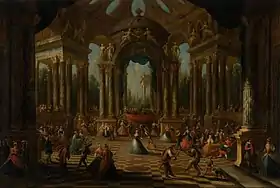
Willem Augustin van Minderhout[1] (Antwerp, baptized on 29 August 1680 – Střílky, 31 May 1752), was a Flemish painter. After training and working in Antwerp, he moved later in his career to work in the area of Moravia which is now in the Czech Republic. He is known for his architectural paintings with figures enjoying themselves with dance, masquerades and other forms of entertainment, and his church interiors.[2] He may also have painted some marine scenes, which was the specialty of his father.[3]
Life
Van Minderhout was born in Antwerp as the son of Hendrik van Minderhout and his father's second wife, Anna Victoria Claus. His father was a Dutch-born marine painter who was primarily active in the Flemish cities Bruges and Antwerp.[4] Willem Augustin had an older brother, Antoon, who was also a painter.[5]

Very little is known about Willem Augustin's training and early career. Unlike his brother, there is no record of him registering as a pupil or a master at the Antwerp Guild of Saint Luke.[6] He likely trained with his father and then worked in his father's workshop.[2]
He married Marie Jacqueline Witlockx, the daughter of Willem Witlockx, who was a well-known bellfounder in his time. They had a son named Willem Hendrik. After his wife died, he commenced a peripatetic life which would bring him to the Holy Roman Empire and in particular Moravia. Here he seems to have been employed on various decorative projects in the palaces of the local aristocracy and higher clergy.[7] He worked on the decoration of the palace halls in Kroměříž Castle, the principal residence of the bishops of Olomouc. At the time Cardinal Ferdinad Julius Troyer (1745–1758) was the resident bishop.[8]
He died in Střílky on 31 May 1752.[2]
Work
Very few of his works have been identified. Van Minderhout is mainly known for his architectural landscapes with figures, and his church interiors.[2] He may also have painted marines with ships at sea or in harbours.[3]

The majority of his known works show imaginary architecture which serves as the setting for scenes with elegant figures dancing or enjoying a masquerade. An example are the pair of Masquerades in the Moravian Gallery in Brno. In one of the two, figures are shown in an impressive open colonnaded hall which appears to be set in a park. The exaggerated perspective of the architecture draws in the eye of the viewer. The fantastic architecture comprises marble columns decorated with statues, garlands and draperies. It serves as the stage for the entertainment of noble ladies and men in fanciful costumes who are seen dancing to the tunes of music or sitting around tables. Some form of performance also seems to be on process. At the back is an elevated balcony from which viewers are watching the people below. These types of pictures served as decorations for palaces. They played on the interaction between the real and the illusionary palaces and were popular with the elites at the time.[8]
An early Flemish painting tradition of depicting ball scenes had been developed by the Antwerp painter Hieronymus Janssens, who himself may have been inspired by Rubens' garden of love paintings.[9] The painter Jacobus Ferdinandus Saey regularly painted the fantastic architecture for Hieronymus Janssens' ball scenes.[10] Antwerp painter Jacob Balthasar Peeters, whose work must have been familiar to van Minderhout as he was a pupil of his father, also painted fantastic architectures with elegant figures in exotic costumes.[11] In addition to these homegrown sources, van Minderhout may also have drawn inspiration for his masquerade pictures from Claude Gillot's prints of comedia dell'arte scenes, and the work of the Flemish painter Hendrick Govaerts from Antwerp, who was also active in Central Europe.[8]
References
- ↑ Name variations: Willem Augustin Minderhout, Willem van Minderhout, Willem Augustijn van Minderhout, Gulielmus van Minderhout
- 1 2 3 4 Willem Augustin van Minderhout at the Netherlands Institute for Art History
- 1 2 Willem Augustin van Minderhout (Attributed to), Quay at Vanderkinderen Brussels auction on 22 March 2017 lot 318
- ↑ Hendrik van Minderhout at the Netherlands Institute for Art History
- ↑ Antoon van Minderhout at the Netherlands Institute for Art History
- ↑ Ph. Rombouts and Th. van Lerius (eds.), De liggeren en andere historische archieven der Antwerpsche sint Lucasgilde Volume 2, Antwerp, 1864, pp. 521 and 648 (in Dutch)
- ↑ William Henry James Weale, Catalogue du musée de l'Académie de Bruges, Beyaert-Defoort, 1861, p. 83 (in French)
- 1 2 3 Zora Wörgötter, "Masquarade I" in "Discover Baroque Art", Museum With No Frontiers 2020
- ↑ Mary Tavener, Nicolas Lancret: Dance Before a Fountain, Holmes Getty Publications, p. 13-14
- ↑ Jacobus Ferdinandus Saey, A Palace Capriccio beside a Fountain with a Soldier and Elegant Figures in the Foreground at Sotheby’s
- ↑ Olaf Koester, Flemish paintings, 1600–1800, Statensmuseum for kunst, 2000, p. 179
External links
 Media related to Willem Augustin van Minderhout at Wikimedia Commons
Media related to Willem Augustin van Minderhout at Wikimedia Commons